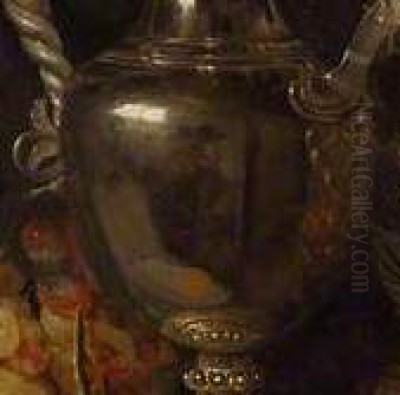
Abraham Hendrickz. van Beyeren stands as one of the most significant painters of still life during the Dutch Golden Age. Active throughout the turbulent and prosperous 17th century, Van Beyeren carved a unique niche for himself, initially exploring marine painting before dedicating his immense talent to the depiction of inanimate objects. He is particularly celebrated for his opulent 'pronkstillevens', or sumptuous banquet pieces, and his remarkably lifelike fish still lifes, genres in which he displayed an unparalleled mastery of texture, light, and composition. Though perhaps less famous during his own lifetime compared to some contemporaries, his reputation has deservedly grown, and he is now recognized as a pivotal figure in the development of Baroque still life painting in the Netherlands.
Early Life and Artistic Beginnings
Born in The Hague around 1620 or 1621, Abraham van Beyeren's early life is somewhat sparsely documented, a common fate for many artists of the period. It is known, however, that he began his artistic training in Leiden. Records indicate that in 1636, he was apprenticed to Tyman Aertsz. Cracht, a painter of diverse subjects. This initial training likely provided Van Beyeren with a solid foundation in the technical aspects of painting, preparing him for his future specializations.
His early artistic inclinations leaned towards marine painting. The Netherlands, a dominant maritime power, had a strong tradition of seascapes, popularized by artists like Jan Porcellis and Simon de Vlieger. Van Beyeren's seascapes, often depicting turbulent waters and dramatic skies, show the influence of prominent contemporaries, most notably Jan van Goyen, known for his atmospheric and tonal landscapes and seascapes. These early works demonstrate Van Beyeren's skill in capturing movement and atmosphere, qualities that would later translate into the dynamic arrangements of his still lifes. In 1640, Van Beyeren registered with the Guild of Saint Luke in The Hague, formally marking his status as an independent master painter.
A Life of Movement and Artistic Evolution
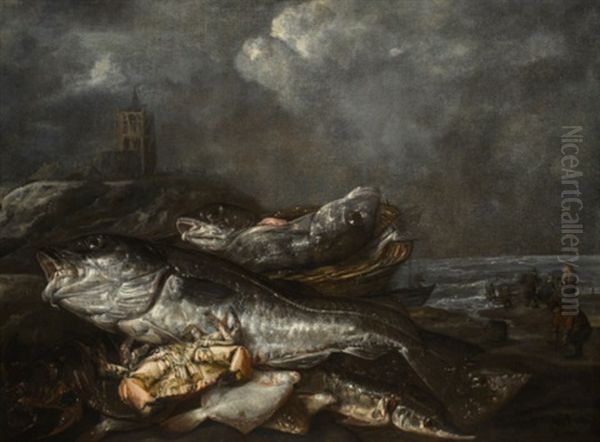
Van Beyeren's career was characterized by frequent relocations, a pattern that suggests a life marked by a degree of instability, possibly financial. After his initial period in The Hague, he moved to Leiden around 1638-1639, where he married Emmerentia Stercke in 1639. He returned to The Hague by 1640, remaining there for a significant period, becoming a respected member of the artistic community. In 1656, he was one of the founding members of the 'Confrerie Pictura', an association established by painters seeking independence from the traditional Guild of Saint Luke.
However, his time in The Hague ended around 1657 when he moved to the vibrant city of Delft, home to artists like Johannes Vermeer and Carel Fabritius. His stay in Delft lasted until about 1663, after which he returned once more to The Hague. The pattern continued: he moved to Amsterdam around 1669, then to Alkmaar in 1674, and subsequently to Gouda in 1675. His final years were spent in Overschie, a village near Rotterdam, where he died and was buried in 1690.
Contemporary accounts and archival records suggest that Van Beyeren often struggled financially. Despite his evident talent, his paintings, particularly the still lifes that are now highly prized, commanded relatively low prices during his lifetime. His somewhat looser, more painterly brushwork, compared to the highly detailed finish favoured by artists like Gerrit Dou or Frans van Mieris the Elder, might have contributed to this. His frequent moves may well have been driven by the need to escape creditors or seek better market opportunities, a poignant counterpoint to the luxurious subjects he often depicted.
The Turn to Still Life: Fish and Banquets
Sometime during the 1640s, while still occasionally painting seascapes, Van Beyeren began to focus increasingly on still life. His initial foray into this genre was through fish still lifes. The Netherlands' reliance on the sea meant fish were a common part of the diet and economy, making them a relatable subject. Van Beyeren brought an extraordinary realism to these compositions. He depicted glistening scales, the wet sheen of freshly caught fish, crabs, lobsters, oysters, and mussels, often arranged on simple wooden tables or shorelines.
His fish still lifes are remarkable for their cool, silvery tonalities and the almost tangible rendering of different textures – the rough skin of a ray, the smooth surface of a salmon, the hard shell of a crab. These works established him as a leading specialist in this subgenre, rivaling dedicated fish painters like Pieter de Putter or Jacob Gillig. His skill lay not just in mimicry but in arranging these elements into compositions that were both naturalistic and artistically satisfying.
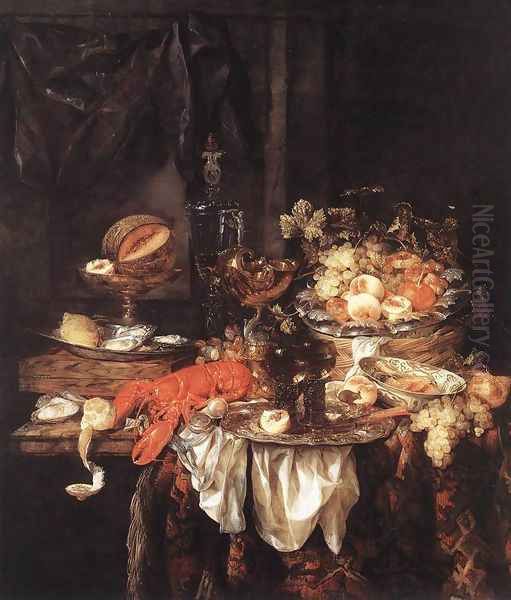
Building on his success with fish still lifes, Van Beyeren moved towards the genre for which he is perhaps most famous today: the pronkstilleven. Emerging in the mid-17th century, these ostentatious still lifes reflected the increasing wealth and global trade connections of the Dutch Republic. Artists like Jan Davidsz. de Heem, who worked in both Utrecht and Antwerp, and Willem Kalf in Amsterdam, were pioneers of this style, and Van Beyeren quickly became one of its most brilliant exponents.
Master of the Pronkstilleven
The pronkstilleven, or sumptuous still life, was a celebration of material wealth and sensory pleasure. Van Beyeren's canvases in this genre are typically large and filled with an abundance of luxurious objects. Silver and gold vessels, intricate glassware (like Venetian-style 'façon de Venise' goblets or Dutch 'roemers'), expensive Chinese blue-and-white porcelain imported via the Dutch East India Company, richly patterned tablecloths (often Turkish carpets or velvet drapes), exotic fruits like lemons and pomegranates, peeled fruits revealing juicy interiors, lobsters, oysters, and elaborate pastries crowd his compositions.
Van Beyeren arranged these items with a sense of dynamic, almost precarious, abundance. Compositions often feature strong diagonal lines, created by rumpled tablecloths, leaning silverware, or cascading fruit. This contrasts with the more ordered, stable arrangements found in the earlier, more sober 'ontbijtjes' (breakfast pieces) by artists like Pieter Claesz or Willem Claeszoon Heda. Van Beyeren's approach was distinctly Baroque, emphasizing movement, drama, and richness.
His technical brilliance was fully deployed in these works. He captured the cold gleam of silver, the transparent fragility of glass (often including reflections of the studio window), the soft pile of velvet, the rough texture of a lemon peel, and the delicate skin of a grape with breathtaking virtuosity. His brushwork, while often appearing loose and fluid up close, coalesces into a convincing illusion of reality when viewed from a distance. He masterfully used chiaroscuro – strong contrasts between light and shadow – to model forms, create depth, and highlight the most important objects in the composition.
Artistic Style and Technique Summarized
Van Beyeren's style evolved throughout his career but retained certain core characteristics, especially in his mature still lifes. His compositions are typically complex and asymmetrical, often built along diagonals that lend energy to the scene. While early works might feature cooler palettes, his later banquet pieces often employ a rich, warm tonality, dominated by reds, golds, and browns, punctuated by the cooler notes of silver, glass, and blue porcelain.
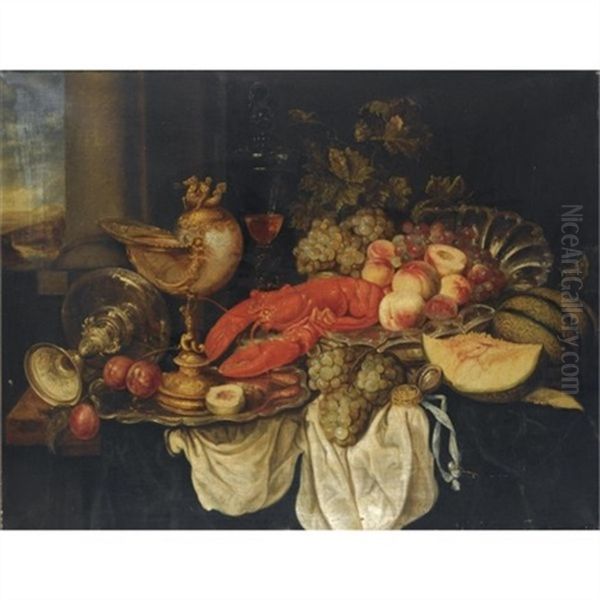
His handling of light is consistently masterful. He understood how light interacts with different surfaces, capturing reflections, refractions, and the subtle interplay of light and shadow that defines form and texture. Unlike the 'fijnschilders' (fine painters) of Leiden, such as Gerrit Dou, who aimed for an almost invisible brushstroke and enamel-like finish, Van Beyeren often employed a more visible, painterly technique. This approach lends his work a vibrancy and immediacy, suggesting the textures rather than minutely detailing every single element. This looser style, however, may have contributed to his lower market value during a time when meticulous finish was often highly prized.
Comparisons are often drawn with his contemporaries. While Jan Davidsz. de Heem might achieve a brighter, more decorative effect, and Willem Kalf a more profound sense of stillness and monumental presence, Van Beyeren excels in conveying a sense of opulent disarray and the sheer materiality of the objects depicted. His work shares the Baroque interest in drama and richness seen across Europe, though adapted to the specific tastes and context of the Dutch Republic. Even the great Rembrandt van Rijn, primarily a history and portrait painter, occasionally painted still lifes that share a similar interest in rich textures and dramatic lighting.
Hidden Meanings: Vanitas and Morality
Beyond the surface display of luxury, Van Beyeren's still lifes, like much of Dutch Golden Age art, often contain deeper symbolic meanings, particularly related to the concept of vanitas. In a society shaped by Calvinist values, which emphasized piety and warned against excessive attachment to worldly goods, these paintings served as subtle moral reminders.
Elements within the compositions often allude to the transience of life and the fleeting nature of earthly pleasures. A pocket watch, frequently included, points to the passage of time. Flowers might be shown slightly wilting, or fruit beginning to decay. An overturned goblet or a partially eaten pie suggests that the feast is over or interrupted. Sometimes, though less common in Van Beyeren's work than in dedicated vanitas painters like Harmen Steenwijck, a skull might appear.
These symbols encouraged viewers to look beyond the immediate sensory appeal of the luxurious objects and reflect on mortality and the importance of spiritual rather than material wealth. The very abundance depicted could be interpreted as a warning against excess. Thus, Van Beyeren's pronkstillevens operated on multiple levels: as displays of technical skill, celebrations of Dutch prosperity, and complex allegories on the human condition.
Representative Works
While Van Beyeren did not always date his works, making precise chronology difficult, several paintings stand out as representative of his oeuvre:
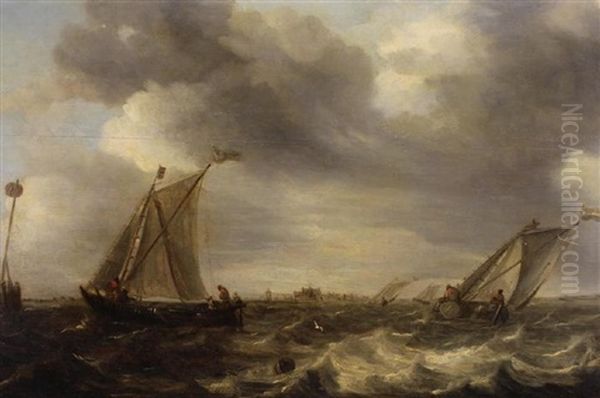
Fish Still Lifes: Numerous examples exist, often titled simply Still Life with Fish or Still Life with Seafood. A notable example is Still Life: Cod, Flounder, Crab and Lobster, housed in the Kelvingrove Art Gallery and Museum, Glasgow. These works showcase his mastery in rendering the textures and silvery tones of marine life, typically arranged near a shoreline or on a simple wooden surface.
Banquet Still Life (c. 1667): Housed in the Los Angeles County Museum of Art (LACMA), this large canvas is a quintessential example of Van Beyeren's mature pronkstilleven. It features a dazzling array of silverware, a prominent nautilus cup, Chinese porcelain, glassware, fruits (including peeled lemons and pomegranates), a lobster, and rich textiles, all arranged in a dynamic, cascading composition under dramatic lighting.
Still Life with Fruit and Lobster: Many variations on this theme exist in museums worldwide, including the Rijksmuseum in Amsterdam and the Mauritshuis in The Hague. These typically combine the elements of the banquet piece – silverware, glass, porcelain – with a focus on abundant fruit and often a striking red lobster, demonstrating his skill with both texture and colour.
Sumptuous Still Life: This title is often applied to his most elaborate banquet pieces. One such example, sometimes noted for having been previously misattributed, showcases his characteristic opulent display, emphasizing the gleam of metal and the richness of fabrics and food items.
Rough Sea: Representing his earlier phase, paintings with titles like this demonstrate his engagement with the marine tradition influenced by Jan van Goyen, capturing the drama and atmosphere of the North Sea.
These works, whether focusing on the humble fish or the most luxurious banquet, consistently reveal Van Beyeren's exceptional ability to capture the essence of materials and arrange them into compelling artistic statements.
Personal Life Details
Van Beyeren's personal life intertwined with his peripatetic career. His first marriage to Emmerentia Stercke in Leiden in 1639 produced three daughters. Following Emmerentia's death, Van Beyeren married Anna van den Querbeek in The Hague in 1647. Anna was the daughter of the painter Crispijn van den Queborn and, intriguingly, the niece of Van Beyeren's first wife. This second marriage produced at least two sons. The complexities of his family life, coupled with his financial uncertainties and frequent moves, paint a picture of a life perhaps as tumultuous as the seas he depicted in his early paintings.
Contemporaries and Artistic Milieu
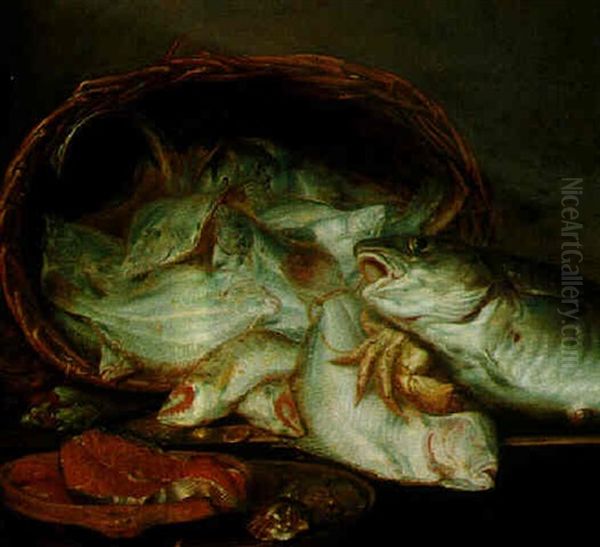
Van Beyeren operated within a rich and competitive artistic environment. His teacher, Tyman Aertsz. Cracht, provided his initial training. His seascapes show the clear influence of Jan van Goyen. In the realm of still life, he was acutely aware of, and responded to, the work of major figures. Jan Davidsz. de Heem and Willem Kalf were key contemporaries in developing the pronkstilleven. He also worked alongside artists specializing in different genres in the cities he inhabited: Delft boasted Johannes Vermeer and Carel Fabritius (though Fabritius died relatively young); Amsterdam was the domain of Rembrandt and his circle; Haarlem had masters of sober still life like Pieter Claesz and Willem Claeszoon Heda, whose work provides a contrast to Van Beyeren's opulence.
While direct collaboration seems undocumented, his participation in the Hague Guild and the Confrerie Pictura placed him in direct contact with fellow artists. His work can also be seen in the broader context of Baroque art across Europe. The Flemish painters Frans Snyders and Adriaen van Utrecht, for instance, also created large, opulent still lifes and market scenes, though often with a greater emphasis on live animals and a more robust, arguably less refined, energy than Van Beyeren's Dutch counterparts. Landscape painters like Jacob van Ruisdael were contemporaries exploring different facets of the Dutch environment. Van Beyeren's unique contribution was his specific blend of technical mastery, compositional dynamism, and focus on the luxurious still life within this vibrant Dutch context.
Legacy and Market Reception
Despite his undeniable talent, Abraham van Beyeren did not achieve widespread fame or financial security during his lifetime. His works were often sold for modest sums, and his name was less celebrated than those of contemporaries like De Heem or Kalf, or the Leiden 'fijnschilders'. His somewhat looser brushwork and perhaps his itinerant lifestyle may have hindered the establishment of a more lucrative reputation. There are instances recorded where his works were even misattributed to other, more famous artists, such as a case involving Jan Davidsz. de Heem noted by an Amsterdam auction house.
However, posterity has been kinder to Van Beyeren. Over time, art historians and collectors came to recognize the exceptional quality of his work. His technical skill, particularly in rendering textures like silver and fish scales, is now widely admired. His pronkstillevens are considered among the finest examples of the genre, embodying the confidence and material wealth of the Dutch Golden Age while simultaneously hinting at its underlying moral complexities.
Today, Van Beyeren's paintings are highly sought after and command significant prices on the art market. Auction results, like the estimate cited for a Still Life with Fruit at Beijing Rong Bao in 2022, reflect his current high standing. His works are prominently displayed in major museums across the world, including the Rijksmuseum, the Mauritshuis, the Louvre, the Metropolitan Museum of Art, LACMA, and the Kelvingrove Art Gallery, ensuring his legacy as a master of Dutch Baroque still life. The rediscovery and correct attribution of his works continue, solidifying his position in the canon of art history.
Conclusion
Abraham van Beyeren was a painter of extraordinary talent whose career traced a fascinating path from dramatic seascapes to the intricate world of still life. As a master of the fish still life, he captured the bounty of the sea with unparalleled realism. In his celebrated pronkstillevens, he orchestrated dazzling displays of luxury, showcasing not only the wealth of the Dutch Republic but also his own virtuoso ability to render diverse textures and manipulate light and shadow. Though perhaps undervalued in his own time and living a life marked by instability, his artistic legacy has endured. Abraham van Beyeren is now rightfully recognized as one of the giants of Dutch Golden Age painting, a key figure in the development of the Baroque still life whose works continue to captivate viewers with their technical brilliance, compositional energy, and rich symbolic resonance.